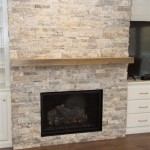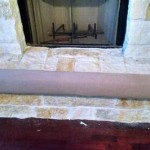Stacked Stone Tile Fireplace Surround: A Comprehensive Guide
A fireplace serves as a focal point in many homes, providing warmth and ambiance. The surround, the area framing the firebox, significantly contributes to the overall aesthetic. Among the diverse materials available for fireplace surrounds, stacked stone tile offers a unique blend of rustic charm and contemporary appeal. This article delves into the advantages, considerations, installation, and maintenance of stacked stone tile fireplace surrounds, providing a comprehensive understanding for homeowners considering this option.
Stacked stone tile, often referred to as ledgestone, is composed of natural stone pieces adhered to a backing material to form interlocking panels. These panels are designed for easy installation, mimicking the appearance of individually placed stones. The texture and variation inherent in natural stone create a visually appealing and tactile surface, adding depth and character to a fireplace. The use of stacked stone tile introduces an element of nature indoors, creating a connection to the outdoors and fostering a sense of tranquility.
Advantages of Stacked Stone Tile Fireplace Surrounds
Stacked stone tile offers several advantages as a fireplace surround material. These advantages span aesthetic appeal, installation efficiency, and long-term durability, making it a popular choice for homeowners seeking to enhance their living spaces.
First, its aesthetic versatility is a significant advantage. Stacked stone tile is available in a wide range of colors, textures, and stone types, allowing homeowners to customize the surround to complement their existing décor. From the cool grays and blues of quartzite to the warm browns and tans of sandstone, the options are virtually limitless. Furthermore, the varied textures create visual interest, enhancing the overall architectural design of the room. Whether the desired style is modern, rustic, or traditional, stacked stone tile can be adapted to suit the specific aesthetic requirements.
Second, the relatively straightforward installation process is a key benefit. Compared to installing individual stones, stacked stone tile panels simplify the process, reducing both time and labor costs. The panels are designed to interlock, creating a seamless and cohesive appearance. While professional installation is recommended for optimal results, experienced DIY enthusiasts can also undertake the project with careful planning and execution. This ease of installation contributes to the overall affordability of stacked stone tile as a fireplace surround material.
Third, durability and longevity are inherent characteristics of stacked stone tile. Natural stone is inherently resistant to heat, moisture, and wear and tear. When properly installed and sealed, a stacked stone tile fireplace surround can withstand the daily rigors of use and maintain its appearance for many years. The durability of the material also translates to lower maintenance requirements, as it is less prone to damage compared to other materials like wood or drywall. This long-term durability makes stacked stone tile a worthwhile investment for homeowners seeking a lasting and visually appealing fireplace surround.
Key Considerations Before Installation
Before embarking on the installation of a stacked stone tile fireplace surround, several crucial considerations must be addressed. These considerations encompass structural compatibility, design planning, material selection, and safety regulations.
First, assessing the structural integrity of the existing fireplace structure is paramount. The weight of stacked stone tile can be substantial, and the underlying structure must be capable of supporting the added load. A professional inspection by a structural engineer or qualified contractor is recommended to ensure that the existing framing and foundation can safely bear the weight of the stone. If the structure is deemed inadequate, reinforcement measures may be necessary, potentially adding to the overall cost and complexity of the project. Neglecting this aspect can lead to structural problems and safety hazards in the long run.
Second, meticulous planning of the design and layout is essential for achieving the desired aesthetic outcome. Factors such as the size and shape of the fireplace, the overall style of the room, and the desired texture and color of the stone must be carefully considered. Creating a detailed plan, including measurements and material calculations, will help prevent errors and ensure a smooth installation process. It is also crucial to consider the placement of electrical outlets, lighting fixtures, and other architectural elements in relation to the stacked stone tile surround. A well-thought-out design plan will minimize waste and maximize the visual impact of the finished fireplace.
Third, selecting the appropriate stacked stone tile is crucial. Not all stacked stone is created equal. Factors such as the type of stone, the quality of the adhesive used to bond the stone to the backing, and the overall thickness of the panel can significantly impact the appearance and durability of the surround. It is advisable to source materials from reputable suppliers and to carefully inspect each panel for defects before installation. Choosing a reputable brand ensures both the longevity and aesthetics of the material. Understanding the specific characteristics of different types of stone will help make an informed decision and achieve the desired aesthetic outcome.
Fourth, adherence to local building codes and safety regulations is an indispensable aspect of the installation process. Fireplace surrounds are subject to specific regulations regarding clearances from combustible materials, fire-resistant construction, and ventilation. Consulting with local building officials or a qualified contractor is essential to ensure that the installation complies with all applicable regulations. Failure to comply with these regulations can result in fines, delays, and potential safety hazards. Adherence to these standards ensures the safety of the occupants and the integrity of the structure.
Installation Process and Best Practices
The installation of a stacked stone tile fireplace surround requires careful planning, preparation, and execution. While professional installation is recommended, experienced DIY enthusiasts can successfully complete the project by following established best practices.
First, preparing the substrate is a critical step. The surface to which the stacked stone tile will be applied must be clean, dry, and structurally sound. Remove any existing paint, wallpaper, or loose debris. If the existing surface is uneven, apply a leveling compound to create a smooth and uniform base. For masonry surfaces, ensure that any cracks or imperfections are repaired before proceeding. A properly prepared substrate provides a solid foundation for the stacked stone tile, ensuring proper adhesion and preventing future problems.
Second, dry-fitting the panels is essential before applying adhesive. Arrange the stacked stone tile panels on the floor in the order they will be installed, paying attention to color variations and texture patterns. This allows for adjustments and ensures a visually appealing and balanced appearance. Trim any panels that need to be cut to fit around corners or openings. Dry-fitting also helps familiarize yourself with the layout and identify any potential problems before committing to the installation.
Third, applying the appropriate adhesive is crucial for securing the stacked stone tile to the substrate. Use a high-quality thin-set mortar specifically designed for use with natural stone. Follow the manufacturer's instructions for mixing and application. Apply the mortar evenly to the back of each panel, using a notched trowel to create ridges that will improve adhesion. Carefully press each panel firmly against the substrate, ensuring that it is properly aligned and level. Remove any excess mortar that squeezes out from the joints.
Fourth, grouting the joints is an optional step that can enhance the appearance and durability of the stacked stone tile surround. If desired, select a grout color that complements the stone and apply it carefully to the joints between the panels. Use a grout float to press the grout into the joints and remove any excess. Allow the grout to dry according to the manufacturer's instructions, then clean the surface with a damp sponge. Sealing the grout after it has fully cured will help prevent staining and moisture penetration.
Fifth, sealing the stacked stone tile is highly recommended. Applying a stone sealer helps protect the stone from staining, moisture, and other potential damage. Choose a sealer specifically designed for use with natural stone and follow the manufacturer's instructions for application. Reapply the sealer periodically as needed to maintain its protective properties. This step ensures longevity and preserves the visual appeal of the stacked stone tile.
Finally, maintain a clean work environment during the installation process. Use drop cloths to protect flooring and furniture from mortar and grout spills. Clean up any spills immediately to prevent staining. Wear safety glasses and gloves to protect yourself from dust and chemicals. Proper ventilation is also important, especially when working with adhesives and sealers. A clean and organized work environment contributes to a more efficient and safe installation process.

12 Stacked Stone Fireplace Ideas For Optimal Coziness

12 Stacked Stone Fireplace Ideas For Optimal Coziness

5 Stacked Stone Surrounds Travertine Quartzite Or Marble
.jpg?strip=all)
Tips And Tools For Professional Stacked Stone Fireplaces

Natural Stacked Stone Veneer Fireplace Ideas

17 Modern Stacked Stone Fireplace Ideas For Your Home

Pin On Woodworking

Fireplace Stone Tile Remodel

17 Modern Stacked Stone Fireplace Ideas For Your Home

Tiling A Stacked Stone Fireplace Surround Bower Power
Related Posts








